How does our brain work or how to model the soul?

Hello, Geektimes! In a previously published article , a model of the nervous system was presented, I will describe the theory and principles that formed its basis.
The theory is based on the analysis of available information about the biological neuron and nervous system from modern neurobiology and physiology of the brain.
First, I will give brief information about the object of modeling, all the information is described below, taken into account and used in the model.
NEURON
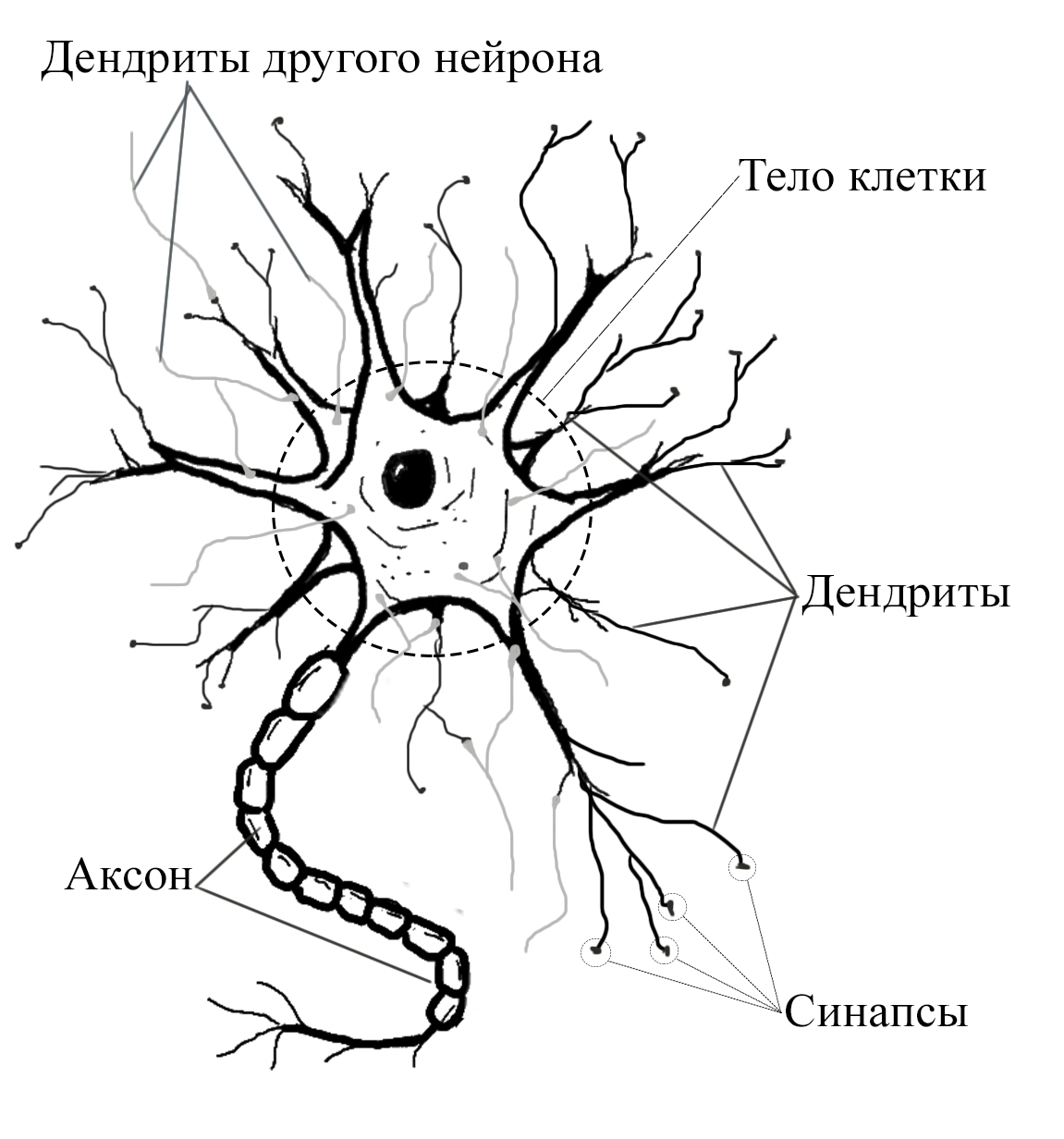
A neuron is the main functional element of the nervous system, it consists of the body of a nerve cell and its processes. There are two types of processes: axons and dendrites. Axon is a long process covered with myelin sheath, designed to transmit a nerve impulse over long distances. Dendrite is a short, branching process, due to which there is a relationship with many neighboring cells.
THREE TYPES OF NEURONS
Neurons can vary greatly in shape, size and configuration, despite this, there is a fundamental similarity of nervous tissue in different parts of the nervous system, and there are no serious evolutionary differences. The nerve cell of the aplisia mollusk can secrete the same neurotransmitters and proteins as the human cell.
Three types of neurons are distinguished depending on the configuration:
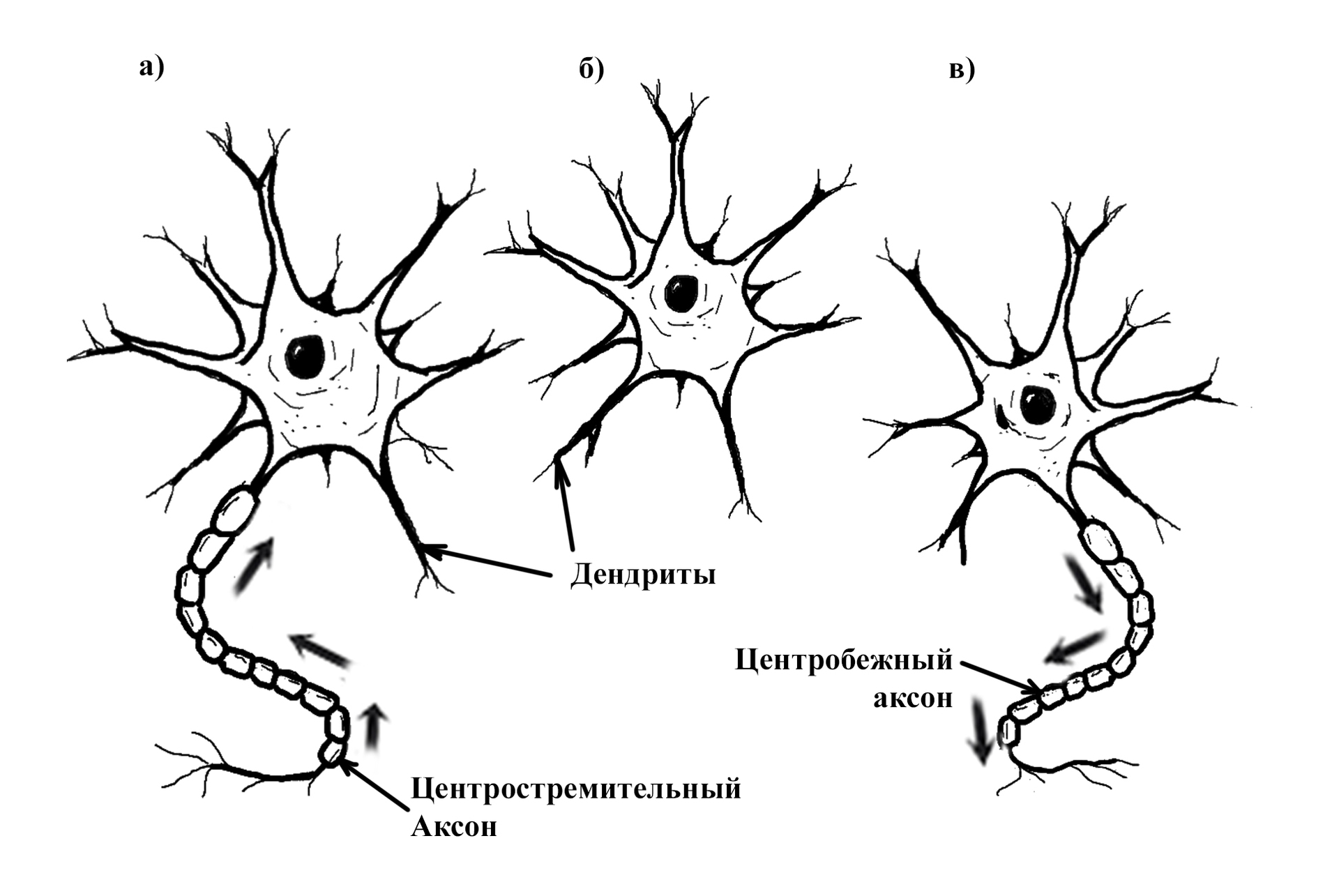
a) receptor, centripetal, or afferent neurons, these neurons have a centripetal axon, at the end of which there are receptors, receptor or afferent endings. These neurons can be defined as elements that transmit external signals to the system.
b) interneurons (insertion, contact, or intermediate) neurons that do not have long processes, but only have dendrites. There are more such neurons in the human brain than others. This type of neuron is the main element of the reflex arc.
c) motor, centrifugal, or efferent, they have a centripetal axon, which has efferent endings that transmit excitation to muscle or glandular cells. Efferent neurons serve to transmit signals from the nervous environment to the external environment.
Usually, articles on artificial neural networks stipulate the presence of only motor neurons (with a centrifugal axon), which are connected into layers of a hierarchical structure. A similar description is applicable to the biological nervous system, but it is a kind of special case, we are talking about structures, basic conditioned reflexes. The higher the evolution of the nervous system, the less prevail in it structures like “layers” or a strict hierarchy.
NERVOUS EXCITATION TRANSFER
The transmission of excitation occurs from neuron to neuron, through special thickenings at the ends of dendrites, called synapses. According to the type of transmission, synapses are divided into two types: chemical and electrical. Electrical synapses transmit a nerve impulse directly through the point of contact. There are very few such synapses in the nervous systems; they will not be taken into account in the models. Chemical synapses transmit a nerve impulse through a special mediator substance (neurotransmitter, neurotransmitter), this type of synapse is widespread and implies variability in work.
It is important to note that changes are constantly taking place in a biological neuron, new dendrites and synapses are growing, and neuron migration is possible. Neoplasms are formed at the points of contact with other neurons, for the transmitting neuron it is a synapse, for the receiver it is a postsynaptic membrane equipped with special receptors that respond to the mediator, that is, we can say that the neuron membrane is a receiver, and synapses on dendrites are transmitters signal.
SINAPSE
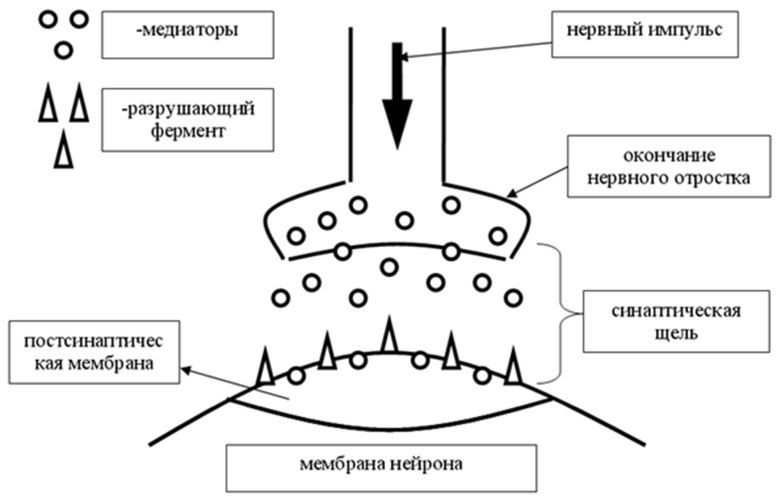
When the synapse is activated, it ejects portions of the mediator, these portions can vary, the more the mediator is secreted, the more likely that the received signal will be activated by the nerve cell. The mediator, breaking the synoptic cleft, enters the postsynaptic membrane, on which receptors that respond to the mediator are located. Further, the mediator can be destroyed by a special destructive enzyme, or absorbed back by the synapse, this happens to reduce the time of the action of the mediator on the receptors.
In addition to the stimulus, there are synapses that inhibit the neuron. Typically, such synapses belong to certain neurons, which are designated as inhibitory neurons.
There can be many synapses connecting a neuron with the same target cell. To simplify, we will accept the entire set of actions exerted by one neuron on another target neuron at the synapse with a certain effect force. The main characteristic of a synapse will be its strength.
STATE OF EXCITATION OF A NEURON
At rest, the neuron membrane is polarized. This means that particles carrying opposite charges are located on both sides of the membrane. At rest, the outer surface of the membrane is positively charged, the inner is negative. The main carriers of charges in the body are sodium ions (Na +), potassium (K +) and chlorine (Cl-).
The difference between the charges on the surface of the membrane and inside the cell body is the membrane potential. The mediator causes a violation of polarization - depolarization. Positive ions outside the membrane rush through open channels into the cell body, changing the ratio of charges between the surface of the membrane and the cell body.
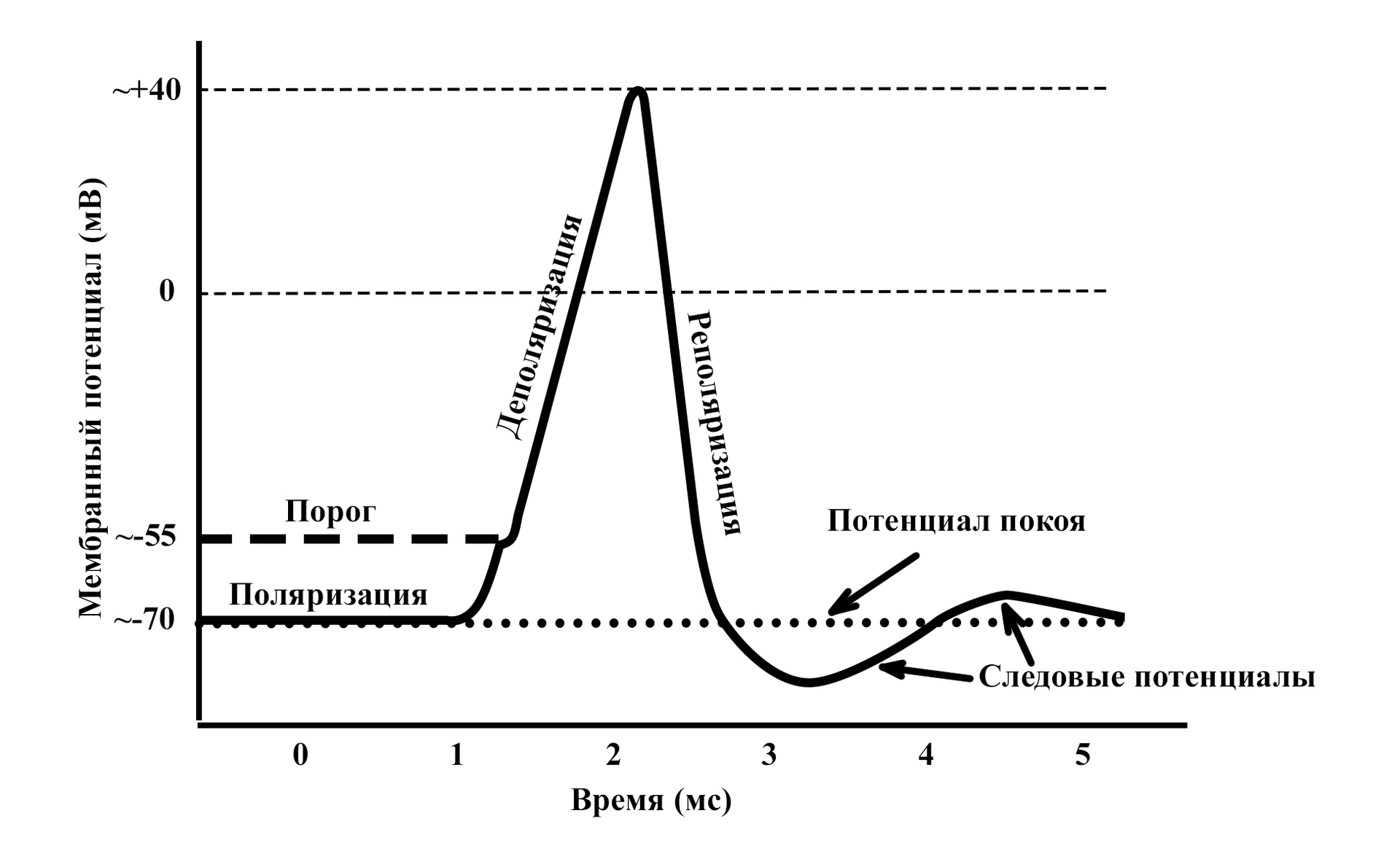
Change in membrane potential upon excitation of a neuron
The nature of changes in membrane potential during activation of nerve tissue is unchanged. Regardless of how much force is applied to the neuron, if the force exceeds a certain threshold value, the answer will be the same.
Looking ahead, I want to note that even trace potentials matter in the work of the nervous system (see the graph above). They do not appear, due to some harmonic oscillations balancing charges, are a strict manifestation of a certain phase of the state of the nervous tissue upon excitation.
THEORY OF ELECTROMAGNETIC INTERACTION
So, I will give further theoretical assumptions that will allow us to create mathematical models. The main idea is the interaction between the charges formed inside the cell body, during its activity, and charges from the surfaces of the membranes of other active cells. These charges are opposite, in this connection it can be assumed how the charges will be located in the cell body under the influence of charges of other active cells.
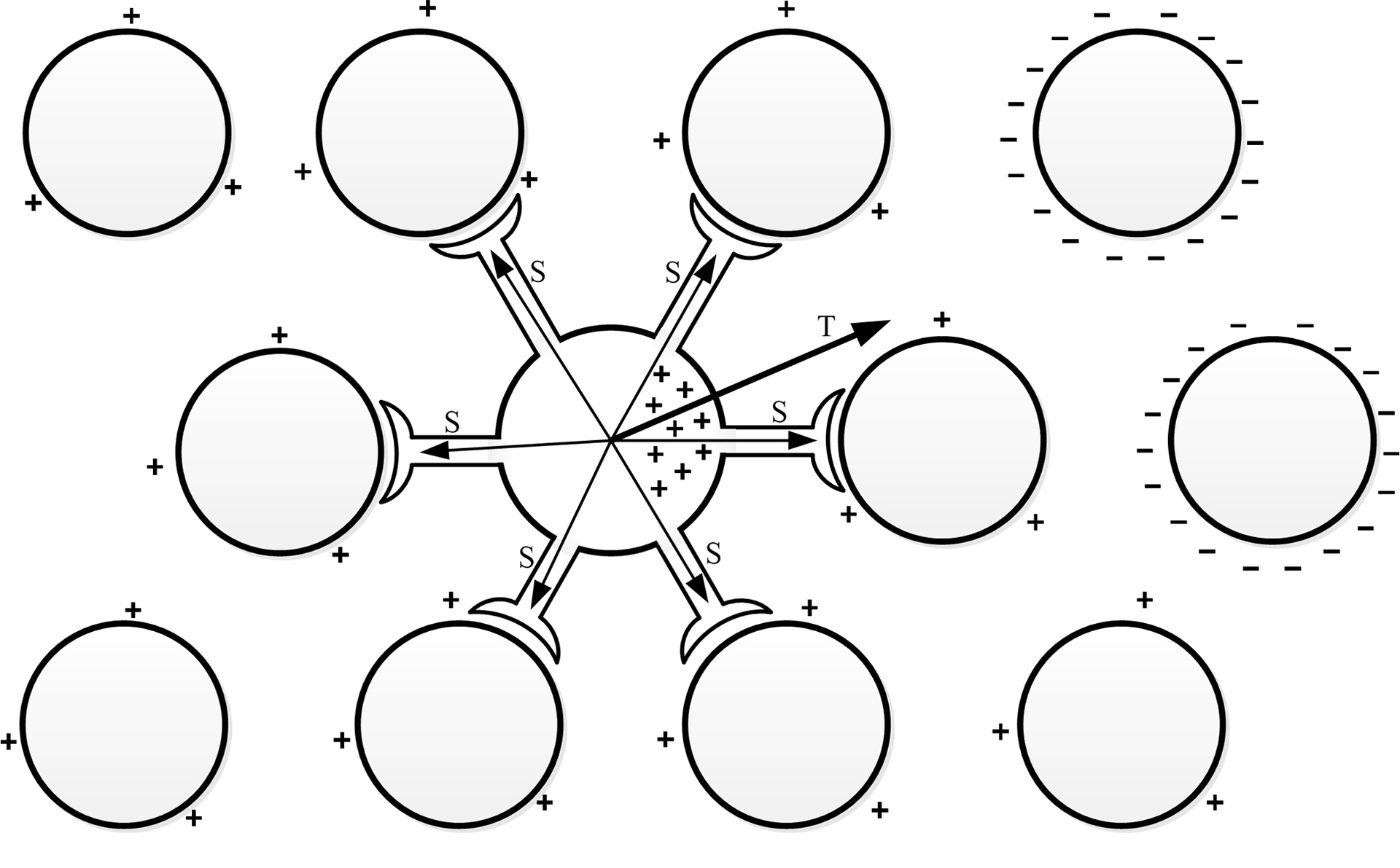
We can say that the neuron senses the activity of other neurons at a distance, seeks to direct the propagation of excitation in the direction of other active sites.
At the moment of neuron activity, a certain point in space can be calculated, which would be defined as the sum of the masses of charges located on the surfaces of other neurons. We will call this point a pattern point; its field depends on a combination of the phases of activity of all neurons of the nervous system. A unique combination of active cells is called a pattern in physiology of the nervous system, that is, we can talk about the effect of excited brain regions on the functioning of a single neuron.
It is necessary to imagine the work of the neuron not just as a computer, but a kind of excitation repeater that selects the directions of propagation of the excitation, so complex electrical circuits are formed. Initially, it was assumed that the neuron simply selectively disconnects / turns on its synapses for transmission, depending on the preferred direction of excitation. But a more detailed study of the nature of the neuron led to the conclusion that the neuron can change the degree of influence on the target cell through the strength of its synapses, which makes the neuron a more flexible and variable computing element of the nervous system.
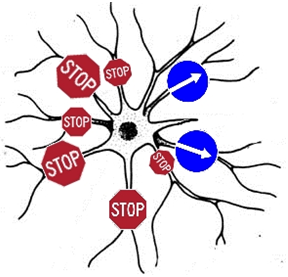
Which direction for transmission of excitation is preferred? In various experiments associated with the formation of unconditioned reflexes, it can be determined that pathways or reflex arcs are formed in the nervous system that connect the activated brain regions during the formation of unconditioned reflexes, and associative connections are created. This means that the neuron must transmit excitations to other active parts of the brain, remember the direction and use it in the future.
Imagine the beginning vector, which is located in the center of the active stand, and the end is directed to the pattern point defined for a given neuron. Denote as the vector of the preferred direction of propagation of the excitation (T, trend). In a biological neuron, the vector T can manifest itself in the structure of the neuroplasm itself, perhaps these are channels for the movement of ions in the body of the cell, or other changes in the structure of the neuron.
A neuron has the property of memory, it can remember the vector T, the direction of this vector, can change and overwrite depending on external factors. The degree to which the vector T can undergo changes is called neuroplasticity.
This vector, in turn, affects the functioning of the neuron synapses. For each synapse, we define the vector S beginning, which is located in the center of the cell, and the end is directed to the center of the target neuron with which the synapse is connected. Now the degree of influence for each synapse can be determined as follows: the smaller the angle between the vector T and S, the more the synapse will be, amplified; the smaller the angle, the stronger the synapse will weaken and may possibly stop the transmission of excitation. Each synapse has an independent memory property, it remembers the meaning of its strength. The indicated values change with each activation of the neuron, under the influence of the vector T, they either increase or decrease by a certain value.
MATHEMATICAL MODEL
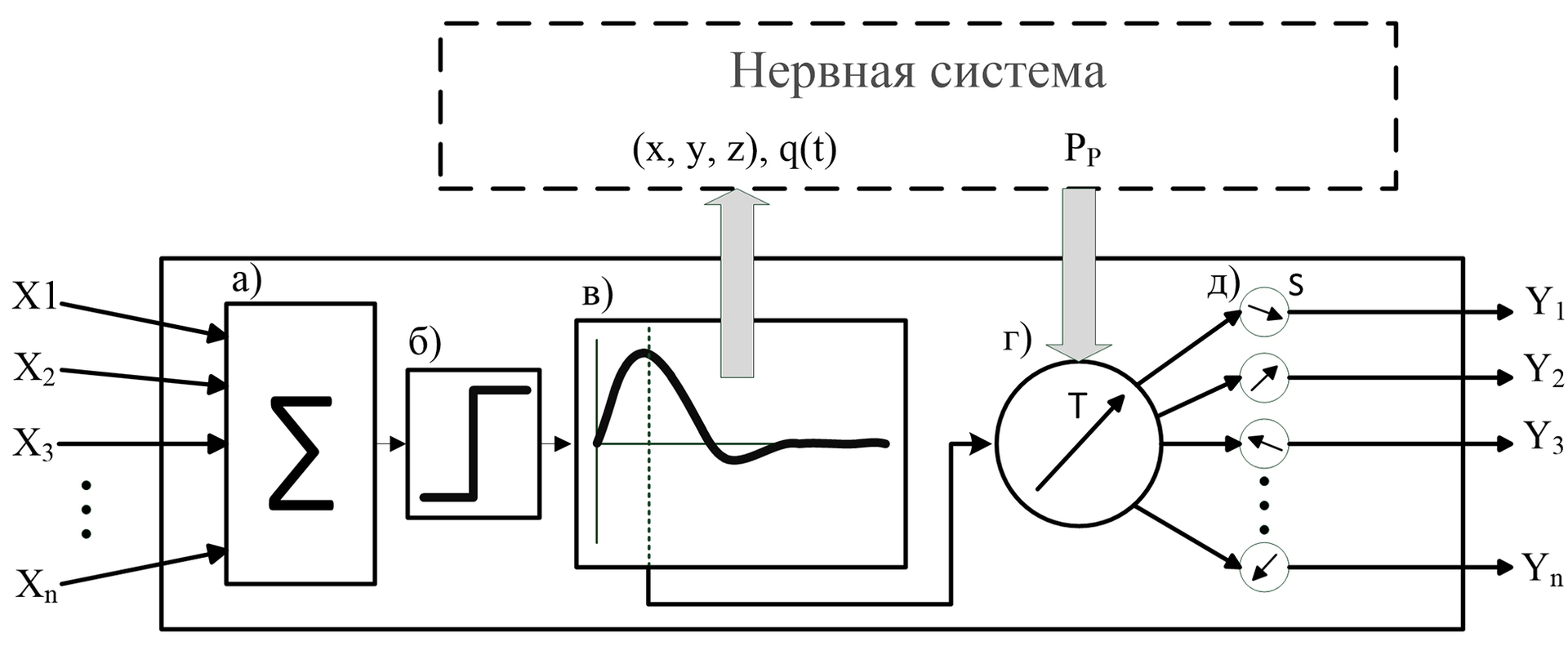
The input signals (x1, x2, ... xn) of the neuron are real numbers that characterize the strength of the synapses of the neurons that affect the neuron.
A positive value of the input means a stimulating effect on the neuron, and a negative value means a inhibitory effect.
For a biological neuron, it does not matter where the signal exciting it came from, the result of its activity will be identical. A neuron will be activated when the sum of the effects on it exceeds a certain threshold value. Therefore, all signals pass through adder (a), and since neurons and the nervous system work in real time, therefore, the effect of the inputs should be evaluated in a short period of time, that is, the effect of the synapse is temporary.
The result of the adder passes the threshold function (b), if the sum exceeds the threshold value, then this leads to neuron activity.
When activated, a neuron signals its activity to the system, advanced information about its position in the space of the nervous system and the charge, which changes in time (in).
After a certain time, after activation, the neuron transmits excitation along all the available synapses, previously recounting their strength. The whole period of activation of a neuron ceases to respond to external stimuli, that is, all the effects of synapses of other neurons are ignored. The activation period also includes the recovery period of the neuron.
The vector T (g) is adjusted taking into account the value of the pattern point Pp and the level of neuroplasticity. Next, there is a reassessment of the values of all the forces of the synapses in the neuron (d).
Note that blocks (g) and (e) are executed in parallel with block (c).
WAVE EFFECT
If you carefully analyze the proposed model, you can see that the source of excitation should have a greater effect on the neuron than another remote, active part of the brain. Therefore, the question arises: why is there still a transfer in the direction of another active site?
I was able to identify this problem only by creating a computer model. The solution suggested a graph of changes in membrane potential during neuron activity.
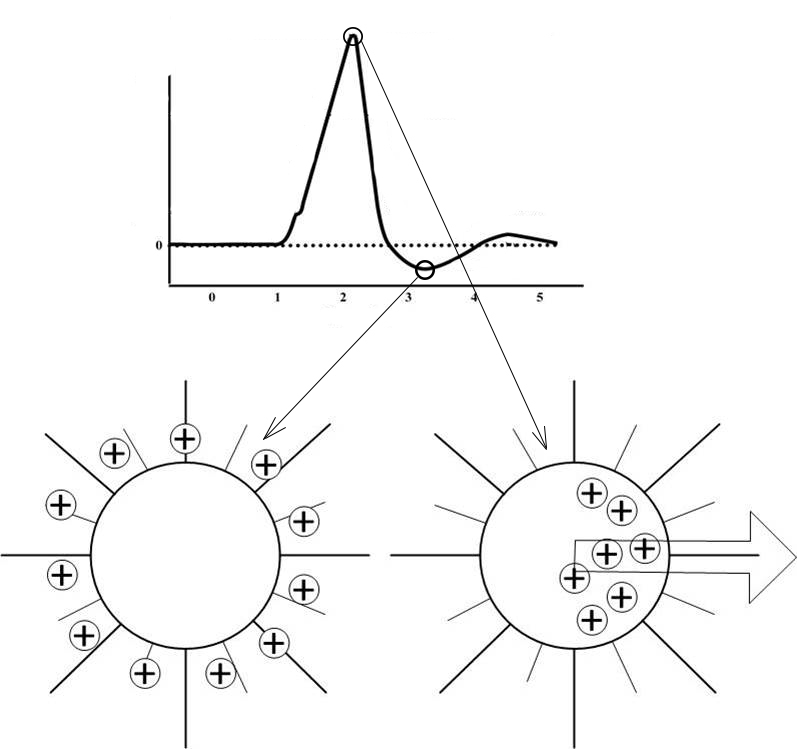
Enhanced repolarization of the neuron, as mentioned earlier, is important for the nervous system, thanks to it the effect of the wave is created, the desire for nervous excitation to spread from the source of excitation.
When working with the model, I observed two effects, if we neglected the trace potential or made it not large enough, then the excitation does not propagate from the sources, but rather tends to localization. If you make the trace potential very large, then the excitement tends to "scatter" in different directions, not only from its source, but also from others.
COGNITIVE MAP
Using the theory of electromagnetic interaction, many phenomena and complex processes that occur in the nervous system can be explained. For example, one of the latest discoveries that is widely discussed in the brain sciences is the discovery of cognitive maps in the hippocampus.
The hippocampus is the part of the brain that is responsible for short-term memory. Experiments on rats revealed that a certain place in the maze corresponds to its own localized group of cells in the hippocampus, and it does not matter how the animal gets to this place, the area of nerve tissue corresponding to this place will be activated anyway. Naturally, the animal must remember this maze, do not rely on the topological correspondence of the space of the maze and the cognitive map.
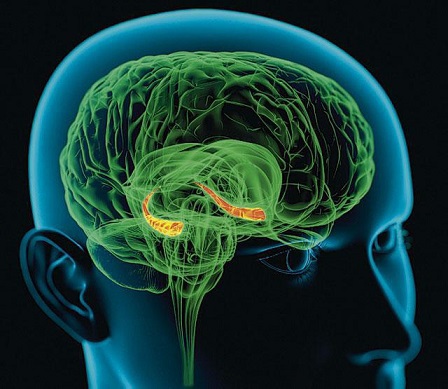
Each place in the labyrinth is represented in the brain as a set of stimuli of a different nature: smells, color of walls, possible notable objects, characteristic sounds, etc. These stimuli are reflected in the cortex, various representations of the senses, in the form of bursts of activity in certain combinations. The brain simultaneously processes information in several departments, often the information channels are divided, the same information goes to different parts of the brain.
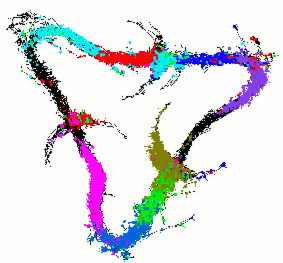
Activation of place neurons depending on the position in the maze (the activity of different neurons is shown in different colors). a source
The hippocampus is located in the center of the brain, the entire car and its areas are removed from it, at equal distances. If for each unique combination of stimuli we determine the mass point of the charges on the surfaces of neurons, we can see that these points will be different and will be located approximately in the center of the brain. Excitation in the hippocampus will tend to these points and spread, forming stable areas of excitation. Moreover, the alternate change of combinations of stimuli will lead to a shift in the point of the pattern. The sections of the cognitive map will associatively associate with each other sequentially, which will lead to the fact that the animal, placed at the beginning of the labyrinth familiar to it, can recall the whole subsequent path.
Conclusion
Many will have a question, where in this work are the prerequisites for the element of rationality or the manifestation of higher intellectual activity?
It is important to note that the phenomenon of human behavior is a consequence of the functioning of the biological structure. Therefore, in order to imitate reasonable behavior, it is necessary to understand well the principles and features of the functioning of biological structures. Unfortunately, a clear algorithm has not yet been presented in the science of biology: how a neuron works, how it understands where it is necessary to grow its dendrites, how to configure its synapses so that a simple conditioned reflex can be formed in the nervous system, similar to those that were demonstrated and described in Academician I.P. Pavlov.
On the other hand, in the science of artificial intelligence, in an upward (biological) approach, there is a paradoxical situation, namely: when the models used in the research are based on outdated ideas about the biological neuron, conservatism, which is based on the perceptron without rethinking its basic principles, without appeals to the biological source, invented increasingly sophisticated algorithms and structures that do not have biological roots.
Of course, no one reduces the merits of classical neural networks, which have provided many useful software products, but playing with them is not the way to create an intellectually functioning system.
Moreover, statements that the neuron is like a powerful computing machine are not uncommon are attributed to the property of quantum computers. Because of this supercomplexity, the impossibility of its repetition is attributed to the nervous system, because this is commensurate with the desire to model the human soul. However, in reality, nature follows the path of simplicity and elegance of its decisions, the movement of charges on the cell membrane can serve both to transmit nerve excitation and to transmit information about where this transfer occurs.
Despite the fact that this work demonstrates how elementary conditioned reflexes are formed in the nervous system, it brings us closer to understanding what intelligence and intelligent activity are.
There are many more aspects of the nervous system: inhibition mechanisms, principles of building emotions, the organization of unconditioned reflexes and training, without which it is impossible to build a qualitative model of the nervous system. There is an understanding, on an intuitive level, of how the nervous system works, the principles of which can be embodied in models.
The creation of the first model helped to refine and correct the idea of the electromagnetic interaction of neurons. Understand how the formation of reflex arcs occurs, how each individual neuron understands how to configure its synapses to obtain associative connections.
At the moment, I began to develop a new version of the program, which will simulate many other aspects of the work of the neuron and nervous system.
I ask you to take an active part in the discussion of the hypotheses and assumptions put forward here, since I can be biased towards my ideas. Your opinion is very important to me.
Model (Windows PC) + tutorial
